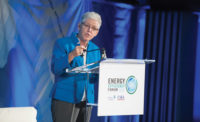Presenting his economic and housing outlook, David Seiders, senior staff vice president and chief economist of the NAHB, noted that this year the Federal Reserve has already made several reductions in interest rates to try to spur the economy. However, he said, “The housing sector has been one of the bright spots in our weakening economy.”
Housing has been holding up very well, but there is now evidence of a leveling.
The NAHB forecast, he related, calls for a dip in growth but no recession. The country will see a better second half and will be stronger still in 2002.
The unemployment rate will rise this year to around 5%, then level off, he predicted. Consumer confidence, though, has shown a substantial decline. Both the present and expectations components are down sharply.
“Housing starts should dip momentarily, then start slowly up again,” Seiders stated. Manufactured housing has “fallen straight down.” He’s forecasting it to bottom out this year and then pick up.
Residential remodeling will continue its modest growth. Residential fixed investment will be down in the second and third quarters, then advance again.
No Recession
Joel Prakken, chairman of Macroeconomic Advisers, LLC, said that we’ll avoid a recession, but there will be below-trend growth. “Housing, however, will fare relatively well.”Why has growth slowed so sharply?
We’ve gone from an overshoot on capital spending to an undershoot, stated Prakken. We have the energy pinch with higher oil, natural gas, and electricity prices. We’re seeing rattled consumer and business confidence. We’re feeling the effects of earlier monetary tightenings by the Federal Reserve. There has also been a faster response to a slowdown by business.
Why will we skirt recession?
Consumer spending and construction are hanging in, Prakken noted. There’s been a weakness in goods demand (inventory backup) and declines in industrial production. But he said that the energy pinch is easing some, and monetary and fiscal policy are turning expansionary. The first quarter will be the weakest, then we’ll see a gradual return to “trend” growth.
Why should growth rebound without a recession?
The inventory adjustment will be largely completed in the second quarter, he stated. A big second-quarter rebound in auto production has been announced. The undershoot on capital spending fades after the first half, he predicted. The Federal Reserve has been cutting short-term interest rates. Mortgage rates are down, boosting housing. And we have “the fiscal stimulus from tax cuts,” said Prakken.
“When the Fed was tightening interest rates, it hurt housing,” he remarked. “Now that it is easing rates, it is helping housing.”

Question Marks
David Jones, chairman of Aubrey G. Lanston & Company, said that he calls for a weaker economic recovery next year. He explained that there are a lot of question marks on the economy because of:Jones said he looks for three quarters of low growth until the second quarter of next year before we return to trend growth.
“We are in a profits recession,” he said. We probably will avoid a technical recession, but if we continue at a slow growth rate, it may feel like one.
What counts regarding a tax cut is whether it is front-loaded, he stated. But the effects won’t come until the fourth quarter of this year, and possibly not until next year.

Good to Be Apartments
Discussing multifamily housing, Jack Goodman, a principal of Hartrey Advisors, said that the multifamily segment has been at a healthy level since 1997. This is occurring even with a record home ownership rate. Apartment renters are at a 1.1% growth rate, which is near the total household growth rate of 1.2%.Why has there been no overbuilding? Goodman pointed out that the multifamily market has better information, as well as memories of 10 years ago, when it seriously overbuilt. “The dumb money has gone elsewhere,” he said.
The long-term prospects are that consumer demand is likely to maintain moderate growth. Financing of supply seems ample, he noted, and the most likely long-term path is a gradual increase in production.
Three niches to watch, he reported, are upscale renters, in-fill locations, and rehab opportunities.
Newly built apartment characteristics are that units are getting bigger — square footage is up 8% — and units are getting better — they include more amenities. However, he said, the condominium share of multifamily starts is surprisingly low.
There are near-term uncertainties, Goodman concluded, but in the long term, to paraphrase Mel Brooks in History of the World Part I, “It’s good to be apartments.”
Apartment Demographics
Looking at demographic trends on apartment demand, Kimberly Fiala, senior vice president, JPI Market Research, said that her firm looks at such demographic data as population growth, net migration, propensity to rent, household formations, income, age, marital status, and job growth to determine apartment demand.The company does consumer surveys of renters, student focus groups on college campuses, and new lifestyle surveys. (A lifestyle survey is a detailed study on personal attitudes, preferences for services and amenities, interests and opinions, and feelings on time and money.)
JPI found that the most highly valued interior amenities include additional soundproofing from the units above and next door, and upgraded appliance packages. The most highly valued exterior amenities include timers on air conditioners and water heaters. Fiala commented that consumers are “moving toward the smart home concept.”
Studying lifestyle preferences enables builders to determine the floor plan design, unit mix, and amenities that will attract desirable renters. It also reveals buying behavior and the media usage that will reach renters.
Publication date: 06/11/2001





